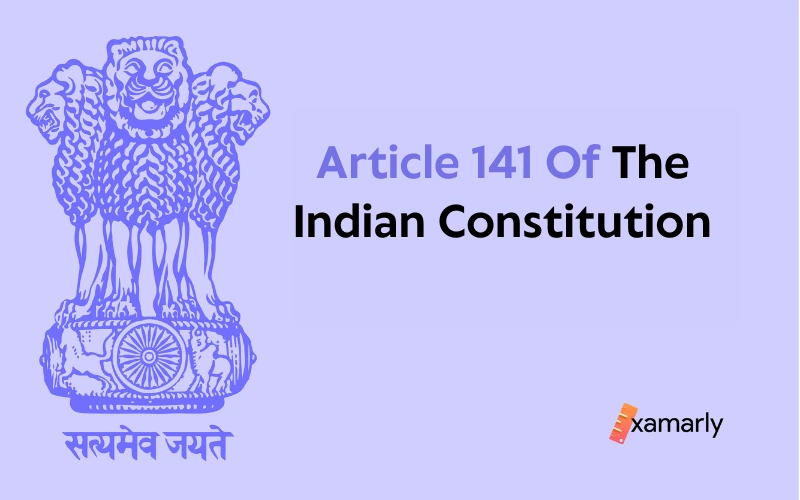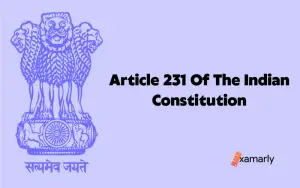Do you know how Indian courts interpret and enforce the laws of the country? Article 141 of the Indian Constitution lays down a very important principle that ensures that all cases are resolved fairly.
Article 141 of the Indian Constitution is considered an elemental law and applies to every court throughout India. It states that the law declared by the Supreme Court is binding in nature and this particular article has been widely credited for increasing uniformity in the application of judicial decisions across different Courts.
The Supreme Court is the highest court in India, and its pronouncements have an extraordinary weight when it comes to legal matters. This article explains what Article 141 of the Indian Constitution means and why it is so important for upholding justice throughout India.
- Article 141 Of The Indian Constitution
- Explanation
- Background
- Is Article 141 of the Indian Court Applicable to the Supreme Court?
- Case Laws
- Bengal Immunity Co. v. the State of Bihar
- Valliamma Champaka Pillai v. Siuvathanu Pillai
- Kerala State Backward Classes (Reservation For Appointment For Posts In Services Under The State) Act, 1955
- Judgments That Lack Binding Force Pursuant To Article 141
- What Is Stare decisis?
- High Court Cannot Overrule The Supreme Court’s Decision
- Conclusion
- FAQs
Article 141 Of The Indian Constitution
It is established in Article 141 of the Indian Constitution that the law pronounced by the Supreme Court is obligatory on all courts within the territory of India.
Explanation
This means that the decisions of the Supreme Court of India are binding on all other courts in the country, and must be followed by all judges and judicial officers. The Supreme Court is the highest court in the country, and its decisions are considered to be final and authoritative on all matters of law.
Background
On May 27, 1949, a discussion took place over Draft Article 117 (Article 141).
It said that all Indian courts have to follow the Supreme Court’s rulings.
One member suggested changing the Draft Article’s phrasing to make the Supreme Court’s rulings enforceable by “all other courts.” The Supreme Court shouldn’t be held to its own rulings, he contended, because that would prevent the court from correcting errors in earlier decisions.
The modification, according to the Chairman of the Drafting Committee, was superfluous because “all courts” actually meant “all other courts.” He made it clear that the Supreme Court was free to alter its legal interpretation as it saw fit and that the Draft Article did not impose any restrictions on the court’s ability to make its own judgments.
It was decided not to adopt the suggested change. On May 27, 1949, the Assembly approved the draught article.
Is Article 141 of the Indian Court Applicable to the Supreme Court?
Article 141 of the Indian Constitution states that the law declared by the Supreme Court shall be binding on all courts within the territory of India. It does not specifically mention the Supreme Court itself.
Therefore, while Article 141 applies to all courts in the country, it does not specifically apply to the Supreme Court. The Supreme Court is the highest court in the country, and its decisions are considered to be final and authoritative on all matters of law. As such, the Supreme Court is not bound by its own decisions and is free to review and reconsider its own decisions if it deems it necessary to do so.
However, it is worth noting that the Supreme Court of India generally follows the principle of stare decisis, which is the principle that courts should follow precedents and abide by previous decisions made in similar cases. This means that the Supreme Court typically follows its own past decisions unless there are compelling reasons to do otherwise.
Case Laws
There have been many cases in which the principles contained in Article 141 of the Indian Constitution have been applied by the courts. Some notable cases involving Article 141 are:
Bengal Immunity Co. v. the State of Bihar
In the context of Article 141 of the Indian Constitution, the term “all courts” should be understood to refer to courts other than the Supreme Court. Therefore, the Supreme Court is not required to uphold its own ruling, but rather is free to review and reevaluate its earlier judgments in light of the newly discovered mitigating factor. In the case of Bengal Immunity Co. v. the State of Bihar, the same conclusion was reached.
Valliamma Champaka Pillai v. Siuvathanu Pillai
The Supreme Court of India ruled in the case of Valliamma Champaka Pillai v. Siuvathanu Pillai that, similar to Article 141 of the Indian Constitution, nothing in the law elevates a high court’s decision to the position of binding on all other high courts and that the doctrine of precedent cannot ever be used to confer binding authority.
Kerala State Backward Classes (Reservation For Appointment For Posts In Services Under The State) Act, 1955
The applicable statutory declaration that there cannot be a creamy layer in the state has been retroactively approved by the Kerala State Backward Classes (Reservation for Appointment for Posts in Services under the State) Act, 1955. The Supreme Court ruled that this particular provision was unlawful as a result. According to Article 141 of the Indian Constitution, the court ruled in Indira Sawhney v. UOI that the creamy layer of classes should not be eligible for reservation benefits. Thus, the Supreme Court’s decision to declare the aforementioned Kerala act invalid was warranted.
These are just a few examples of cases in which the principles contained in Article 141 of the Indian Constitution have been applied by the courts. There have been many other cases in which Article 141 has been invoked and applied by the courts, and it is an important provision that helps to ensure the uniform application of the law and the integrity of the judicial system in India.
Judgments That Lack Binding Force Pursuant To Article 141
The Supreme Court’s judgments in the following categories are not legally binding:
- The decision does not have a valid justification or rationale behind it.
- The decision fails to take into account the most important aspect of the problem at hand.
- Obiter dicta of a ruling do not have the power to bind, but they do have the power to persuade.
- Simply directives from the court, with no legal principles, are established.
What Is Stare decisis?
Stare decisis (also spelled stare decisis) is a Latin phrase that means “to stand by decided cases.” In the legal context, it refers to the principle that courts should follow precedents and abide by previous decisions made in similar cases.
Article 141 of the Indian Constitution enshrines the theory of stare decisis by stating that lower courts must abide by the rulings of higher courts. The Supreme Court is not subject to the Stare Decisis theory; as a result, it is not bound by its own judgments and may overturn them in exceptional or unique circumstances or when doing so for the greater good of the public.
However, stare decisis is not a rigid rule, and courts have the discretion to depart from precedent if they believe it is necessary to do so. This may be the case if the earlier decision was based on an incorrect interpretation of the law, or if there have been significant changes in the law or in the circumstances of the case that make the earlier decision no longer applicable.
High Court Cannot Overrule The Supreme Court’s Decision
In the case of Suganthi Suresh Kumar v. Jagdeesham, the supreme court of the nation correctly said that it is unlawful for the High Court to reverse a ruling made by the Supreme Court only on the grounds that the ruling established principles without taking into account any legal issues.
Furthermore, the Supreme Court explicitly said in the case of Pandurang Kalu Patil v. State of Maharashtra that the rulings of the High Court shall be enforceable as long as the Supreme Court reverses them.
Conclusion
The Supreme Court of India is the highest court in the country, and its decisions are considered to be final and authoritative on all matters of law. By providing that the law declared by the Supreme Court shall be binding on all courts within the territory of India, Article 141 helps to ensure that the decisions of the Supreme Court are followed by all judges and judicial officers in the country and that the same principles of law are applied in all courts.
In the interest of further reading:
| Article 261 Of The Indian Constitution | Article 256 Of The Indian Constitution |
| Article 245 Of The Indian Constitution | Article 262 of the Indian Constitution |
FAQs
What Is Binding Under Article 141?
The ratio of the judgment, not any factual conclusions or the court’s view on any issue that was not necessary to be addressed in a particular case, is what is legally binding. In other words, what makes a decision binding is an underlying concept. In order to determine the true principle established by the provisos ruling in the context of the issue raised in that case, from which the decision draws its hue, the later court should make this effort when implementing the decision in a subsequent case.
Are Decisions Made By The Supreme Court Considered To Be Legislation?
The decision of the Supreme Court cannot be considered “a form of legislation by Parliament,” since this would be to ignore the binding nature of the law that was declared by the court, which is required by article 141 for every subordinate Court to the Supreme Court to accept its ruling. Though it must always be kept in mind that the Supreme Court does not enact legislation, its declarations are binding on other Indian courts.
Is Supreme Courts Decision Bounding Under Article 141?
The decisions of the Supreme Court are binding on all subordinate courts, even if the facts of the matter resolved by the Supreme Court differ from the circumstances before the lower court. According to Article 141 of the Indian Constitution, if the Supreme Court’s observations constituted a declaration of law, they are obligatory on all lower courts.
What Is Article 141 Of The Indian Constitution?
Article 141 of the Indian Constitution is an important provision that states that any decision made by the SC Of India is binding for all the courts on Indian soil. This Article helps to ensure the uniform application of the law and the integrity of the judicial system in India and to maintain the rule of law and the fairness of the judicial system.
What Is The Principle Of Stare Decisis?
Justice is administered with consistency, which is its fundamental tenet. The system’s consistency is what inspires trust in it, and it is impossible to maintain consistency without adhering to the finality rule. The courts developed the rule of precedents, the principle of stare decisis, etc. with the goal of achieving uniformity in judicial decisions. If these rules and principles, which are derived from public policy, are not adhered to by the courts, then the administration of justice will devolve into a state of complete anarchy.






